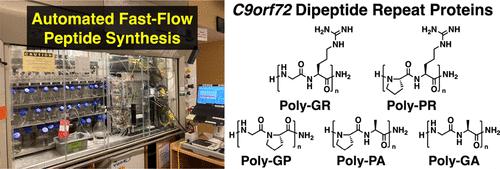当前位置:
X-MOL 学术
›
J. Am. Chem. Soc.
›
论文详情
Our official English website, www.x-mol.net, welcomes your
feedback! (Note: you will need to create a separate account there.)
Automated Fast-Flow Synthesis of Chromosome 9 Open Reading Frame 72 Dipeptide Repeat Proteins
Journal of the American Chemical Society ( IF 14.4 ) Pub Date : 2023-06-09 , DOI: 10.1021/jacs.3c02285 Kohei Sato 1, 2 , Charlotte E Farquhar 2 , Jacob Rodriguez 2 , Bradley L Pentelute 2, 3, 4, 5
Journal of the American Chemical Society ( IF 14.4 ) Pub Date : 2023-06-09 , DOI: 10.1021/jacs.3c02285 Kohei Sato 1, 2 , Charlotte E Farquhar 2 , Jacob Rodriguez 2 , Bradley L Pentelute 2, 3, 4, 5
Affiliation

|
An expansion of the hexanucleotide (GGGGCC) repeat sequence in chromosome 9 open frame 72 (c9orf72) is the most common genetic mutation in amyotrophic lateral sclerosis (ALS) and frontotemporal dementia (FTD). The mutation leads to the production of toxic dipeptide repeat proteins (DPRs) that induce neurodegeneration. However, the fundamental physicochemical properties of DPRs remain largely unknown due to their limited availability. Here, we synthesized the c9orf72 DPRs poly-glycine-arginine (poly-GR), poly-proline-arginine (poly-PR), poly-glycine-proline (poly-GP), poly-proline-alanine (poly-PA), and poly-glycine-alanine (poly-GA) using automated fast-flow peptide synthesis (AFPS) and achieved single-domain chemical synthesis of proteins with up to 200 amino acids. Circular dichroism spectroscopy of the synthetic DPRs revealed that proline-containing poly-PR, poly-GP, and poly-PA could adopt polyproline II-like helical secondary structures. In addition, structural analysis by size-exclusion chromatography indicated that longer poly-GP and poly-PA might aggregate. Furthermore, cell viability assays showed that human neuroblastoma cells cultured with poly-GR and poly-PR with longer repeat lengths resulted in reduced cell viability, while poly-GP and poly-PA did not, thereby reproducing the cytotoxic property of endogenous DPRs. This research demonstrates the potential of AFPS to synthesize low-complexity peptides and proteins necessary for studying their pathogenic mechanisms and constructing disease models.
中文翻译:

9 号染色体开放阅读框 72 二肽重复蛋白的自动化快速流程合成
9 号染色体开放框 72 ( c9orf72 )中六核苷酸 (GGGGCC) 重复序列的扩展是肌萎缩侧索硬化症 (ALS) 和额颞叶痴呆 (FTD) 中最常见的基因突变。该突变导致有毒二肽重复蛋白(DPR)的产生,从而诱发神经退行性变。然而,由于 DPR 的可用性有限,其基本理化性质仍然很大程度上未知。在这里,我们合成了c9orf72DPR 聚甘氨酸-精氨酸 (poly-GR)、聚脯氨酸-精氨酸 (poly-PR)、聚甘氨酸-脯氨酸 (poly-GP)、聚脯氨酸-丙氨酸 (poly-PA) 和聚甘氨酸-使用自动快速肽合成 (AFPS) 合成丙氨酸 (poly-GA),并实现了含有多达 200 个氨基酸的蛋白质的单域化学合成。合成DPR的圆二色光谱表明,含脯氨酸的聚-PR、聚-GP和聚-PA可以采用聚脯氨酸II样螺旋二级结构。此外,尺寸排阻色谱法的结构分析表明,较长的聚-GP 和聚-PA 可能会聚集。此外,细胞活力测定表明,用较长重复长度的poly-GR和poly-PR培养的人神经母细胞瘤细胞会导致细胞活力降低,而poly-GP和poly-PA则不会。从而再现内源性 DPR 的细胞毒性特性。这项研究证明了 AFPS 合成低复杂性肽和蛋白质的潜力,这些肽和蛋白质是研究其致病机制和构建疾病模型所必需的。
更新日期:2023-06-09
中文翻译:

9 号染色体开放阅读框 72 二肽重复蛋白的自动化快速流程合成
9 号染色体开放框 72 ( c9orf72 )中六核苷酸 (GGGGCC) 重复序列的扩展是肌萎缩侧索硬化症 (ALS) 和额颞叶痴呆 (FTD) 中最常见的基因突变。该突变导致有毒二肽重复蛋白(DPR)的产生,从而诱发神经退行性变。然而,由于 DPR 的可用性有限,其基本理化性质仍然很大程度上未知。在这里,我们合成了c9orf72DPR 聚甘氨酸-精氨酸 (poly-GR)、聚脯氨酸-精氨酸 (poly-PR)、聚甘氨酸-脯氨酸 (poly-GP)、聚脯氨酸-丙氨酸 (poly-PA) 和聚甘氨酸-使用自动快速肽合成 (AFPS) 合成丙氨酸 (poly-GA),并实现了含有多达 200 个氨基酸的蛋白质的单域化学合成。合成DPR的圆二色光谱表明,含脯氨酸的聚-PR、聚-GP和聚-PA可以采用聚脯氨酸II样螺旋二级结构。此外,尺寸排阻色谱法的结构分析表明,较长的聚-GP 和聚-PA 可能会聚集。此外,细胞活力测定表明,用较长重复长度的poly-GR和poly-PR培养的人神经母细胞瘤细胞会导致细胞活力降低,而poly-GP和poly-PA则不会。从而再现内源性 DPR 的细胞毒性特性。这项研究证明了 AFPS 合成低复杂性肽和蛋白质的潜力,这些肽和蛋白质是研究其致病机制和构建疾病模型所必需的。









































 京公网安备 11010802027423号
京公网安备 11010802027423号